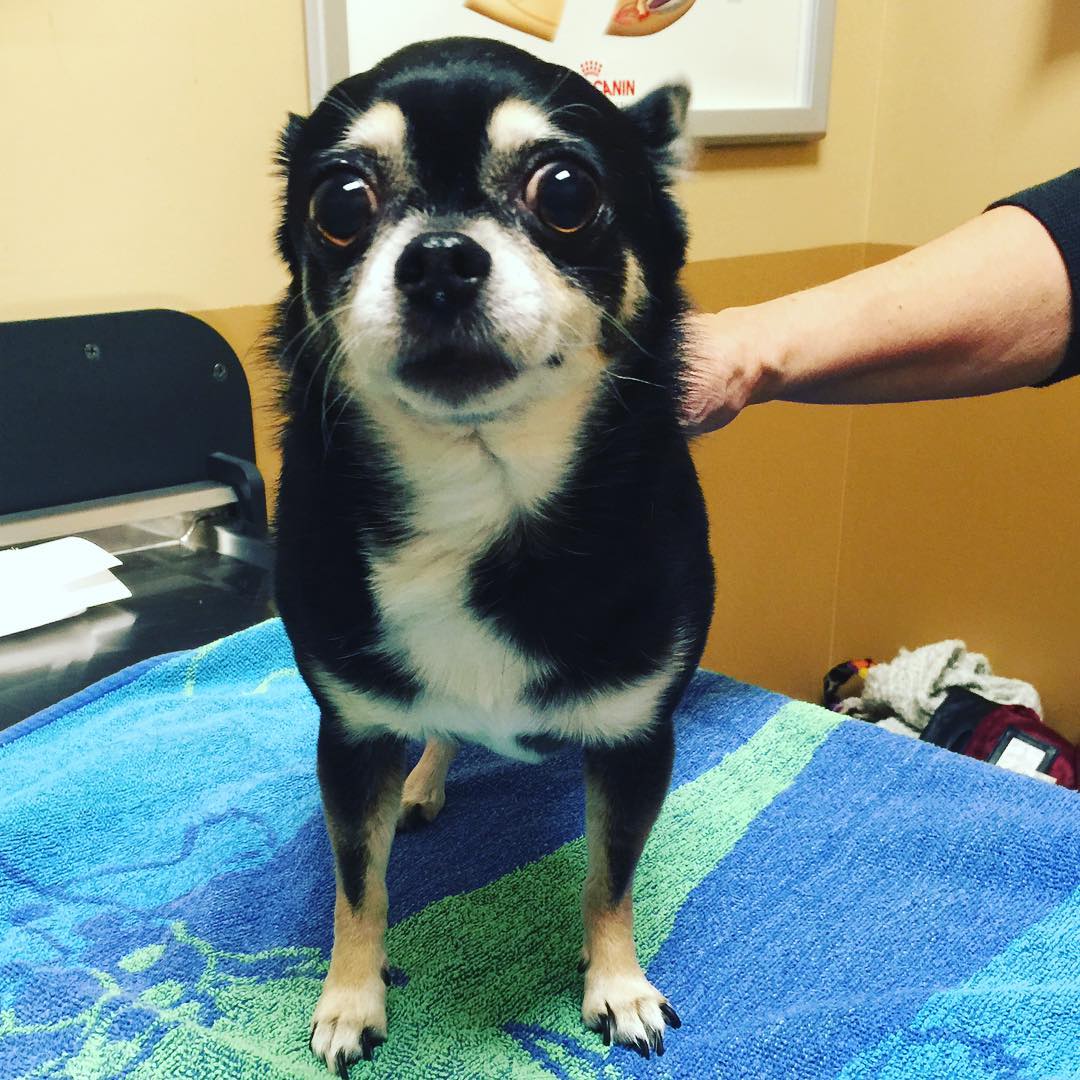Aging is not easy for anyone, especially our dogs. A dog may get weaker in the back end or find it hard to get up and down; she might stop using stairs or experience discomfort. This can be tough for a pet parent to come to grips with.
What if I told you that dog chiropractic care can help? We see it all the time in our practice. It helps with mobility problems, comfort, and activity levels, and can even slow the progression of arthritis. In this article I’ll define who is considered a senior dog, explain what animal chiropractic is, list some issues it helps, and then tell you how to find a properly trained animal chiropractor.
Who Is Considered a Senior Dog?
You probably know that dogs age much faster than humans do. However, did you know that certain breeds and different-size dogs age differently than others? Since, generally speaking, smaller breeds live longer than larger breeds, the best definition for a senior dog is any animal in the last 25 percent of his life, based on the standard for the breed. This is usually when we start to see the symptoms of aging—which can be alleviated by animal chiropractic.
What Is Animal Chiropractic?
Although most people have heard of chiropractic for humans, many people are confused about what chiropractic actually is. Chiropractors are trained to evaluate the spine for structural dysfunction, often referred to as subluxations.
Subluxations are areas in the spine that aren’t moving like they should be or are in the wrong position. When dysfunction like this occurs, inflammation can build up and stress joints, nerves, and more, leading to pain and stiffness. A chiropractor palpates the spine, searching for heat…which would indicate inflammation…for muscle spasm, and for joints that aren’t moving very well. When the chiropractor locates a problematic area, she gives a correction via an adjustment in order to restore normal biomechanics. When it comes to animal chiropractic, the adjustment is very gentle, and there’s typically no cracking or popping.
What Conditions in a Senior Dog Might Be Improved by Animal Chiropractic?
The spine of a senior dog has endured a lifetime of wear and tear. This contributes to difficulties we frequently see in practice, such as:
* Decreased mobility
* Discomfort
* Decreased rear muscle tone
* Arthritis
Many of these symptoms are secondary to subluxations of the spine, and they are often intertwined.
Initially, a joint quits moving well. This doesn’t cause too many problems at a young age, but if it is left uncorrected, inflammation eventually builds to a point where it is uncomfortable for a dog to fully engage a joint. When this happens, a pet owner might notice that a dog doesn’t want to use stairs anymore or really struggles to get comfortable in any position.
Over time, this discomfort starts to affect the muscles. If a dog finds it painful to walk, or to get up from lying down, he will not do it. The muscles start to atrophy, and even more stress is placed on the joints because there’s less muscle to support them. The old adage “Use it or lose it” applies here—a dog will certainly lose muscle tone if she doesn’t use it. This becomes cyclical: The discomfort leads to less movement and more muscle wasting, which leads to even less movement and even more muscle wasting.
This cycle also contributes to arthritis. Arthritis is the result of chronic inflammation and abnormal stress on a joint; it is caused by abnormal biomechanics over a long period of time. A subluxation left uncorrected is exactly this. The lack of normal motion in the joint will lead to an inability to pump inflammation away. The longer the inflammation sits there, the more it eats away at cartilage. In addition, this loads a joint up with abnormal stress, and combined, these factors progressively lead to arthritis.
The great thing about animal chiropractors is that they are trained to find and correct subluxations, which will help alleviate many of the problems senior dogs deal with. An adjustment will restore normal motion to a joint. Restoring motion allows joints to pump inflammation away. With a decrease in inflammation, there’s a decrease in pain. When the pain is gone, the dog is more much more mobile and willing to be active. This will lead to increased muscle tone.
Needless to say, animal chiropractic can be a very important therapy for an aging dog. So who is trained appropriately to work with animals?

Did you find this article useful? Would you like 100% free access to more articles like these, and free access to over 5,000 vetted pet care service professionals throughout the United States? Sign up here for a free Petworks account, and take 10% off your first booking, on us!
How Do I Find an Animal Chiropractor?
There are two routes to becoming an animal chiropractor. Practitioners must first complete veterinary or chiropractic school and receive a doctorate. After that, they attend additional training for animal chiropractic at a different program that includes both textbook and hands-on curricula. At the end of training, they have an opportunity to certify with one of the major boards, among them the American Veterinary Chiropractic Association and the International Veterinary Chiropractic Association.
My personal recommendation would be to search out a chiropractic practitioner on Petworks who is board-certified. If you can’t find someone local, then look for a person who has attended a program in preparation for the boards. Some of these programs include Options for Animals, Healing Oasis, the Parker University Animal Chiropractic Program, or Animal Care Equipment and Services (ACES).
It is inevitable that members of our fur family will age, but fortunately, there are natural solutions, such as animal chiropractic, that can help. Is your pet a senior? Find an animal chiropractor today!
About the Author:
 Dr. Grant Tully received his bachelor’s degree in biomedical science from Auburn University and his chiropractic doctorate from Life University. He then went to Options for Animals in Wellsville, Kansas, where he trained to become an animal chiropractor. After completing the program, he tested and certified with the International Veterinary Chiropractic Association. Dr. Tully is also involved in research for the profession; he and Dr. Christina Cole coauthored a paper on paralyzed dogs who recovered with chiropractic care. They practice together in Southeast Michigan.
Dr. Grant Tully received his bachelor’s degree in biomedical science from Auburn University and his chiropractic doctorate from Life University. He then went to Options for Animals in Wellsville, Kansas, where he trained to become an animal chiropractor. After completing the program, he tested and certified with the International Veterinary Chiropractic Association. Dr. Tully is also involved in research for the profession; he and Dr. Christina Cole coauthored a paper on paralyzed dogs who recovered with chiropractic care. They practice together in Southeast Michigan.
Additional link:
www.advancedanimalchiropractic.com


